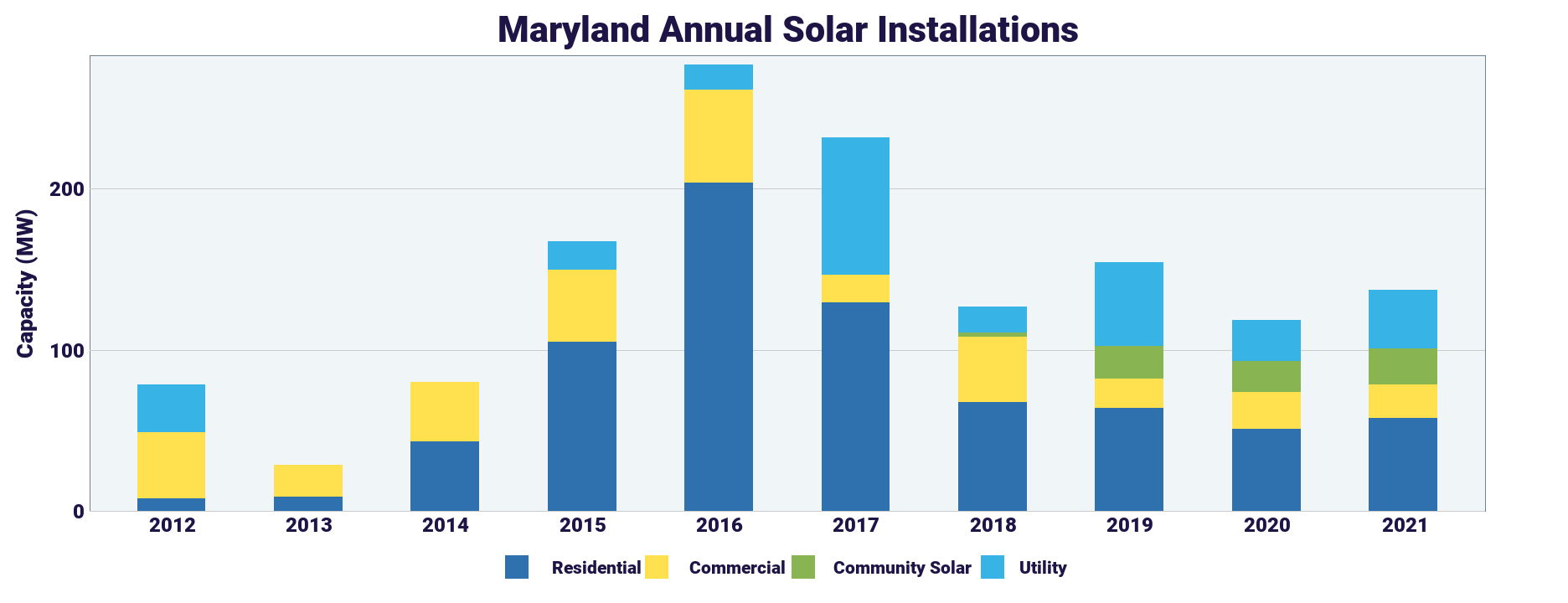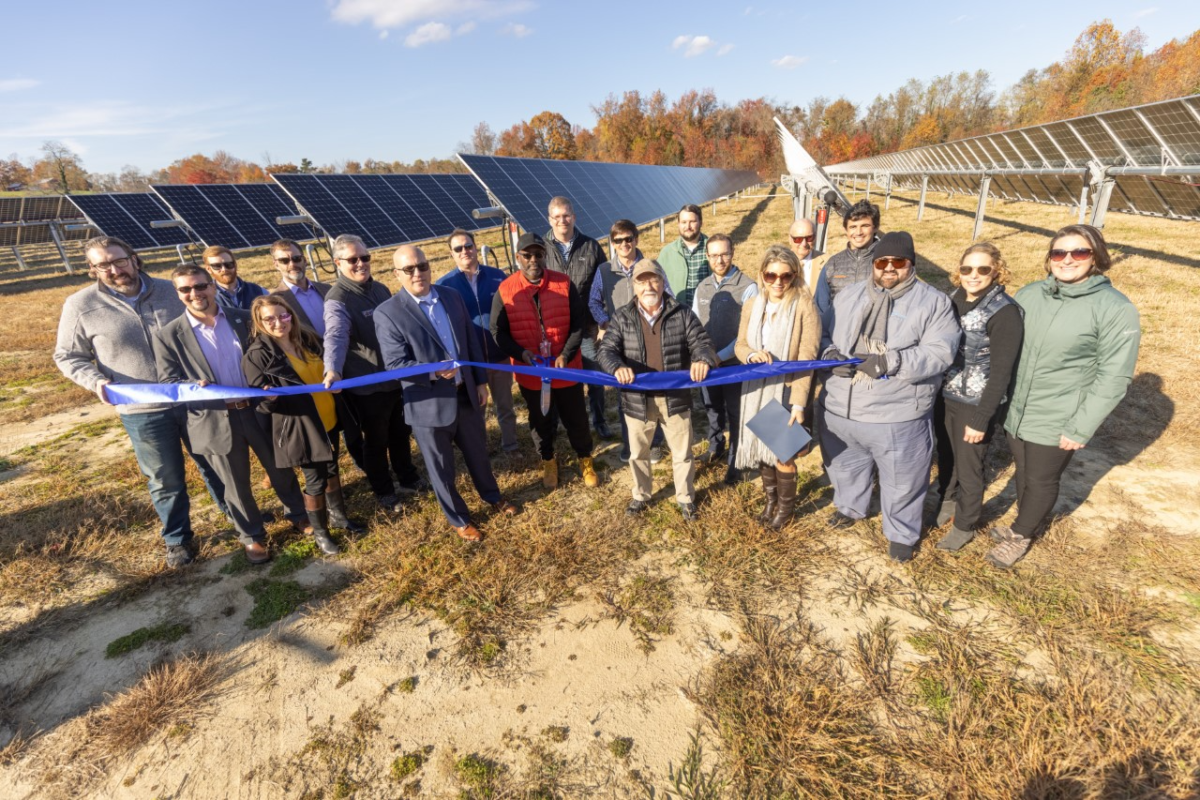The pv magazine USA tour of solar incentives now takes us to our second stop in the DMV: Maryland, which, like its neighbor, Delaware, is one of the most densely-populated states in the country.
Similarly to Delaware, Maryland generates less than 5% of its electricity from solar resources, however this has more to do with the state’s higher population than it does a lack of commitment to solar, at least historically. Maryland, thus far, has installed roughly 1.5 GW of solar, good for 18th in the country, according to data from Wood Mackenzie and the Solar Energy Industries Association (SEIA).

Maryland’s strong start to its solar commitment has slowed down considerably since its peak in 2016, and the state is only expected to install just over 1 GW of solar in the next five years, which currently projects to be 31st in the nation over that time, according to SEIA.
In April, the Maryland Legislature passed the Climate Solutions Now Act of 2022, which speeds up Maryland’s current goal of reducing greenhouse gas emissions from 40% of 2006 levels to 60% by 2031, and it establishes 2045 as the state’s goal for becoming carbon neutral. While Gov. Larry Hogan (R) has said he won’t veto the bill, he won’t sign it either, choosing instead to let it pass on its own.
The American Council on Renewable Energy (ACORE) called the Act “one of the nation’s most robust climate and clean energy policies”, and said it’s legislation that other states can model as it “meets the moment and puts us on track for a sustainable, equitable future.”
The majority of solar capacity installed in Maryland has come through residential projects, so let’s take a look at some of the policies driving residential solar adoption in the Old Line State.
Residential solar
In addition to the federal investment tax credit of 26% for the cost of equipment installed, homeowners in Maryland who choose to go solar are able to sell their excess generation back to the grid at the full retail electricity rate, as part of the state’s strong net metering policy.
Net metering is available to all customers throughout the state until the aggregate capacity of all net-metered systems reaches 3 GW, up from the old peak of 1.5 GW. Net metered system size is set at 2 MW cap, though customers that use electrical service for agriculture may aggregate all of their meters to be served by a single project.
Residential solar systems in Maryland are fully exempt from both state and local county property taxes. Maryland also offers a statewide Residential Clean Energy Grant Program, which provides grants to homeowners who install a number of renewable generation technologies, including solar systems. Administered by the Maryland Energy Administration, homeowners who install a residential solar system of at least 1 kW in capacity are eligible for a rebate of up to $1,000.
C&I initiatives
Like residential customers, commercial and industrial (C&I) customers in Maryland also have access to the state’s strong net metering policy, so long as their installations remain under 2 MW and do not generate more than 200% of the property’s electrical needs.
C&I customers also have access to grants for installing solar systems over parking lots with EV chargers. Such customers must install a minimum of 75 kW of solar canopies over the parking lot with a minimum of four Level II or Level III EV chargers. The program offers grants up to $600 per kW of PV installed, with a maximum cap of $300,000 per project and a total budget, as of Fiscal Year 2021, of $1.6 million.
Community solar
In 2021, regulators in Maryland unanimously voted to expand the capacity of the state’s community solar program as well as improve access for low- and moderate-income (LMI) customer participation in the state’s Community Solar Pilot Program.
According to the Coalition for Community Solar Access, the expansion of the program will allow community solar to power the equivalent of an additional 6,840 Maryland homes annually. The expansion also changed development regulations, allowing community solar projects to be built on clean-fill construction sites, transforming previously unusable industrial locations into clean solar energy generation sites.
Building on that commitment to community solar, in 2022, the Maryland legislature passed a pair of bills targeted at increasing the amount of eligible projects, and increasing the incentive for such projects to be developed.
The first of the two is HB 1039, which exempts community solar projects from both county and municipal corporate property taxes, so long as the 50% of the electricity generated by the projects go to serve low- to moderate-income individuals and families at a rate which is at least 20% lower than the base electricity rate that these customers would be paying otherwise.
As it stands, 30% of the pilot program capacity is still set aside for low-to-moderate income customers wishing to participate and another 30% is set aside for project development on brownfield sites.
The bill also establishes additional tax incentives for the development of agrivoltaic community solar projects on rooftops, brownfields, landfills, and clean fills.
The other bill, HB 440, will expand the maximum capacity of a permitted community solar project from 2 MW to 5 MW, while also reducing the land requirements for siting projects. This provision pertains to projects developed on multiple, contiguous lots, rather than opening up new types of land zones for development.
Last time, the pv magazine tour of the 50 states of solar took us to neighboring Delaware, and next we will continue to travel through the DMV, stopping off in Virginia.
This content is protected by copyright and may not be reused. If you want to cooperate with us and would like to reuse some of our content, please contact: editors@pv-magazine.com.









Please give a contact number for people to get accurate information on how and what to do regarding solar development. I have solar panels on my house but would like more. I would like to know if I would be better off or qualify for community solar or an additional system. What would be the payback time for me?